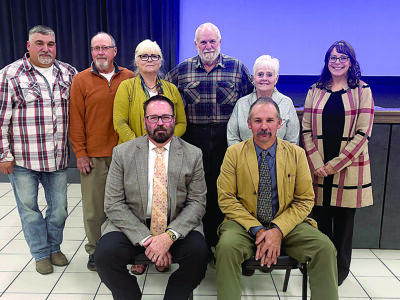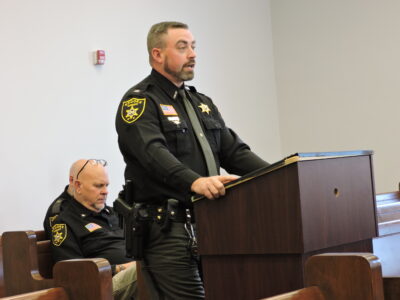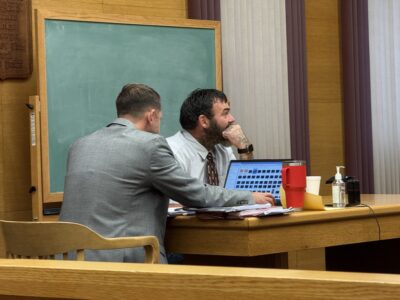POW museum marks 80th anniversary of World War II battle

A MYSTERY TO BE SOLVED — The family of Dr. Charles Osborne, a captain in the Army Medical Corps, has donated to the American Defenders of Bataan and Corregidor Museum in Wellsburg items that belonged to him before he was declared missing in action while serving in the South Pacific during World War II. With a display containing photos of him, letters he wrote to his family and his cigarette lighter are, from left, John, his grandson; Mary Osborne Kizer, his granddaughter; and Lance Kizer, her husband; and Jim Brockman, the museum’s director. -- Warren Scott
WELLSBURG — The bravery and determination of thousands of American and Filippino troops battling Japanese invaders was remembered Saturday while a mystery was presented with the addition to a new display at the American Defenders of Bataan and Corregidor Museum and Education Center.
Jim Brockman, the museum’s director, noted Friday marked the 80th anniversary of the last battle by thousands of Allied troops against Japanese invaders of the Philippine Islands.
He related how Army Major Gen. Jonathan Wainwright surrendered Corregidor and Bataan to Japanese forces following months of battle in which Allied troops dealt with a lack of reinforcements, food and supplies and were struggling with fatigue, starvation and illness.
Brockman said though he had secured Japanese occupation of the islands in five months, Japanese Gen. Masaharu Homa was relieved of his command because he had been expected to accomplish the task in two months.
He noted tens of thousands of Allied survivors were escorted through subtropical heat, with little food or water, on a trek of at least 60 miles that came to be known as the Bataan Death March because of the many who succumbed to its conditions or were killed by their captors.
Brockman said many were transported to prisoner of war camps, where they were used as slave labor for the war effort, by freighters that came to be known as Hell ships because of their crowded holds and inhumane conditions.
He said Dr. Charles Osborne, a captain in the Army Medical Corps, is believed to have been among POWs on a Hell ship torpedoed by two Allied submarines on Oct. 24, 1944.
He noted the Japanese failed to mark vessels carrying POWs, so it wasn’t unusual for them to be targeted by Allied forces.
Brockman said just nine of an estimated 1,774 POWs aboard were able to escape on a life raft and five of them were later recaptured by the Japanese.
Visitors to the museum were invited to view a display with a photo of Osborne, letters sent to his family during his service, a posthumously awarded Purple Heart and a cigarette lighter he used.
On hand were Osborne’s grandchildren, John and Mary Kizer; and Mary’s husband, Lance, who has been seeking information about her grandfather.
Lance said Charles Osborne was known to share his lighter with others and had “Stolen from Dr. Charles E. Osborne MD” inscribed on it to encourage its return.
He said after Charles was declared missing in action, the lighter was returned to his family after being found on the body of a Japanese casualty.
Lance said little is known about Charles’ military service. He said Osborne was a 40-year-old country doctor, the kind known for making house calls, with a wife and two children when he enlisted shortly before America’s entry into the war.
Lance said Charles had reasoned that many young men would need his services as the war progressed.
Lance said he learned of the museum through the Internet and he and other family members felt it would be a good way to preserve Charles’ memory.
Also added to the museum Saturday were photos, military manuals and a Naval cap belonging to Paul Cunningham, who served aboard USS Downes during the Battle of Leyte, through which Allied Forces reclaimed the Philippine Islands, through a combination of air strikes and amphibious assaults, in 1944.
Cunningham’s daughters, Diane Cunningham Lamb and Susan, said their father, who came from the former community of Power near Beech Bottom, enlisted at age 17 after his mother provided the required written consent.
For his service, Cunningham received the Philippine Liberation Ribbon with one bronze star, American Area Campaign Ribbon, World War II Victory Ribbon and Asiatic-Pacific Area Campaign Ribbon.
Brockman noted the USS Downes had been damaged in the bombing of Pearl Harbor but was rebuilt to serve the war effort.
The anniversary observance included a short parade to the Wellsburg Elks Lodge, where lunch was served and attendees were entertained by Filippino folk dancers.
Located within the Brooke County Public Library, the ADBC Museum and Education Center grew from an exbibit created by the late Ed Jackfert and his wife, Henrietta.
Also a POW though not a participant of the Bataan Death March, Jackfert wanted to raise awareness of an often overlooked aspect of World War II.
Since it opened, the museum has been visited by Japanese students wanting to learn more about the POWs’ experience and formal apologies have been issued by the Japanese government and Mitsubishi Materials Co., which used POW labor in producing munitions.
The Japanese company also donated $50,000 to the museum.





